人教版高中英语选修八unit1第1课时教案
人教版高中英语选修八全册教案
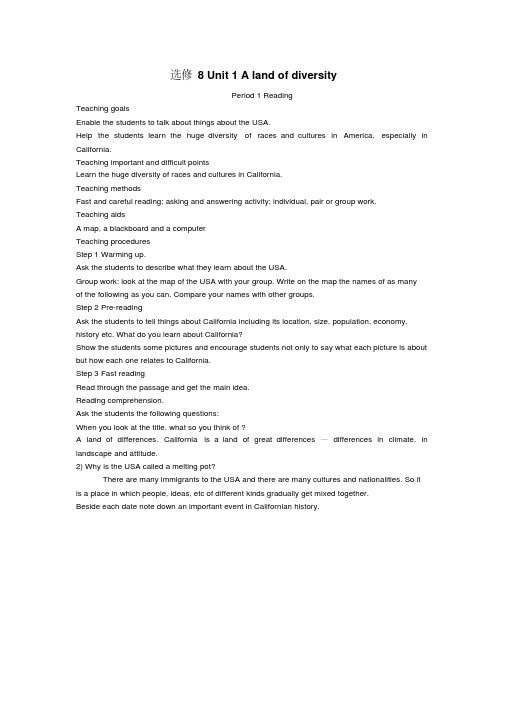
选修8 Unit 1 A land of diversityPeriod 1 ReadingTeaching goalsEnable the students to talk about things about the USA.Help the students learn the huge diversity of races and cultures in America, especially in California.Teaching important and difficult pointsLearn the huge diversity of races and cultures in California.Teaching methodsFast and careful reading; asking and answering activity; individual, pair or group work.Teaching aidsA map, a blackboard and a computerTeaching proceduresStep 1 Warming up.Ask the students to describe what they learn about the USA.Group work: look at the map of the USA with your group. Write on the map the names of as manyof the following as you can. Compare your names with other groups.Step 2 Pre-readingAsk the students to tell things about California including its location, size, population, economy, history etc. What do you learn about California?Show the students some pictures and encourage students not only to say what each picture is about but how each one relates to California.Step 3 Fast readingRead through the passage and get the main idea.Reading comprehension.Ask the students the following questions:When you look at the title, what so you think of ?A land of differences. California is a land of great differences —differences in climate, in landscape and attitude.2) Why is the USA called a melting pot?There are many immigrants to the USA and there are many cultures and nationalities. So it is a place in which people, ideas, etc of different kinds gradually get mixed together.Beside each date note down an important event in Californian history.Step 4 Detail readingBeside each cultural group , write the period in which they first came to California in large numbers.Cultural groups Periods Cultural groups Periods Russians early 1800sJapanese Early 1900sChinese Late 1840s/early 1850s Cambodians From about the 1970s Africans 1800s Koreans From about the 1970 Italians Late 1800s Danish 1911Jewish1920sPakistanisFrom about the 1970sStep 5 After readingWhy is California in the 21st century such a multicultural community? (Using 3 or 4 sentences to explain. ) Step 6 HomeworkFinish “Learning about language ”on page 4.15,000 years ago 16th centure 1821 18461848 1850First settlers crossed the Bening Strait from Asia. These people are now known as Native Americans.Spanish soldiers arrived in South America.California became part of Mexico.The US declared war on Mexico.Gold was discovered in California.California became the 31st state of the US.Period 2 Extensive ReadingTeaching aims: 1. Improve Ss’ ability of reading2. 德育目标:了解美国多元文化,进一步培养学生跨文化交际意识,为终身学习奠定良好基础。
人教版高中英语选修8全册教案

选修8黎巨森、蒋茹、罗培芳、罗丽霞Unit 1 A land of diversityPeriod 1 ReadingTeaching goalsEnable the students to talk about things about the USA.Help the students learn the huge diversity of races and cultures in America, especially in California.Teaching important and difficult pointsLearn the huge diversity of races and cultures in California.Teaching methodsFast and careful reading;asking and answering activity;individual, pair or group work. Teaching aidsA map, a blackboard and a computerTeaching proceduresStep 1 Warming up.Ask the students to describe what they learn about the USA。
Ask the students to tell things about California including its location,size,population,economy,history etc. What do you learn about California?Show the students some pictures and encourage students not only to say what each picture is about but how each one relates to California。
高中英语选修八Unit+1第1课时+教案
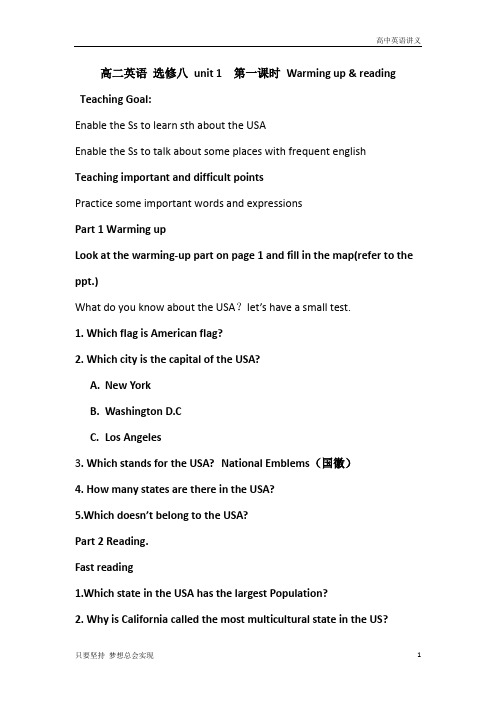
高二英语选修八unit 1 第一课时Warming up & reading Teaching Goal:Enable the Ss to learn sth about the USAEnable the Ss to talk about some places with frequent english Teaching important and difficult pointsPractice some important words and expressionsPart 1 Warming upLook at the warming-up part on page 1 and fill in the map(refer to the ppt.)What do you know about the USA?let’s have a small test.1. Which flag is American flag?2. Which city is the capital of the USA?A.New YorkB.Washington D.CC.Los Angeles3. Which stands for the USA?National Emblems(国徽)4. How many states are there in the USA?5.Which doesn’t belong to the USA?Part 2 Reading.Fast reading1.Which state in the USA has the largest Population?2. Why is California called the most multicultural state in the US?3.How many kinds of people are mentioned in this text?Detail readingNative Americans• 1.Time:• 2.Where did they come from:• 3.What happened to the native Americans in the sixteenth century?Native AmericansThe Spainsh16th century 18th century in 1821 in 1846Influence:today over 40% of Californians speak Spainish as a first or second languageRussians & Gold MinersDo some T or F questions:1.In the early 1800s, Russian fur trappers began settling in California.2.In 1848, before the Amerian-Mexican war, gold was discovered inCalifornia.3.A lot of adventures achieved their dream of becoming rich.4.California become the thirty-first state of the United states of Amerian in 1850.Later arrivalsRecent arrivalsLook at the pictures below. Each illustrates something about California. Discuss in groups what each picture means to you.1.A native American Indian was standing beside a camp .It seemed that he or she felt very happy. Maybe he or she had a good harvest.2.He was a gold miner. He was panning gold. He looked not onlythin and weak, but also thirsty and tired. It was difficult for them to achieve the dream of becoming rich.3.A building in ChinatownMany Chinese have settled in California and many of them live in Chinatown in San Francisco.。
人教课标版高中英语选修8 Unit1_Using_Language_名师教学设计
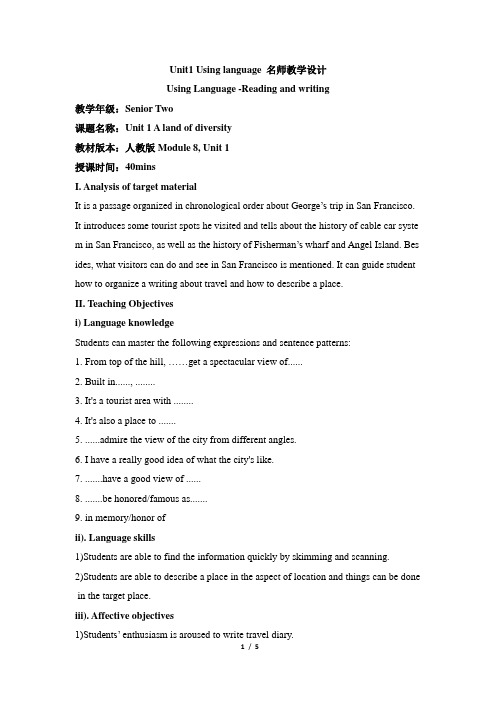
Unit1 Using language 名师教学设计Using Language -Reading and writing教学年级:Senior Two课题名称:Unit 1 A land of diversity教材版本:人教版Module 8, Unit 1授课时间:40minsI. Analysis of target materialIt is a passage organized in chronological order about George’s trip in San Francisco. It introduces some tourist spots he visited and tells about the history of cable car syste m in San Francisco, as well as the history of Fisherman’s wharf and Angel Island. Bes ides, what visitors can do and see in San Francisco is mentioned. It can guide student how to organize a writing about travel and how to describe a place.II. Teaching Objectivesi) Language knowledgeStudents can master the following expressions and sentence patterns:1. From top of the hill, ……get a spectacular view of......2. Built in......, ........3. It's a tourist area with ........4. It's also a place to .......5. ......admire the view of the city from different angles.6. I have a really good idea of what the city's like.7. .......have a good view of ......8. .......be honored/famous as.......9. in memory/honor ofii). Language skills1)Students are able to find the information quickly by skimming and scanning.2)Students are able to describe a place in the aspect of location and things can be done in the target place.iii). Affective objectives1)Students’ enthusiasm is aroused to write travel diary.2)Students’ interest is raised to know more about the history and culture of a place the y visit.III. Key points and difficult points:The core of this lesson is to get students to use the skill of skimming and scanning to f ind the information. Also, this lesson is to get students to introduce a place in the aspe ct of history and things visitors can do in the place. The key expressions will be extrac ted from the text by the students with the guidance of the teacher. Students are suppos ed to apply the expressions and sentence patterns to their writing.IV. Teaching approaches1)The Communicative approach:This lesson contains activities where learners communicate and where tasks are by me ans of interaction among learners with the teacher. There is individual, pair work to fi nish the reading part.2)The task-based Approach: students are required to tell about a trip to a friend in the form of a letter with the useful expressions and sentences they learned.V. Teaching AidsStudents’ book, Learning guidance paper, Blackboard, projector and a multimedia co mputer.VI. Teaching procedure:VII. Self-assessmenti. Good points2).Tasks are designed to help students apply what they have learned in reading to their writing.3) The writing task is an integration of what students learned and the local culture the y are familiar with.4). This lesson can help students form the habit of putting what they have learned into practice.ii.Possible problems1)The reading part may take up a little more time so that there is not enough time for s tudents to exchange their writing and correct it for each other in class.2)Students’ writings need to be presented through a projector so that the failure will u ndermine its effectiveness.VIII. Board Design。
人教版高中英语选修8Unit1Alandofdiversityword教案
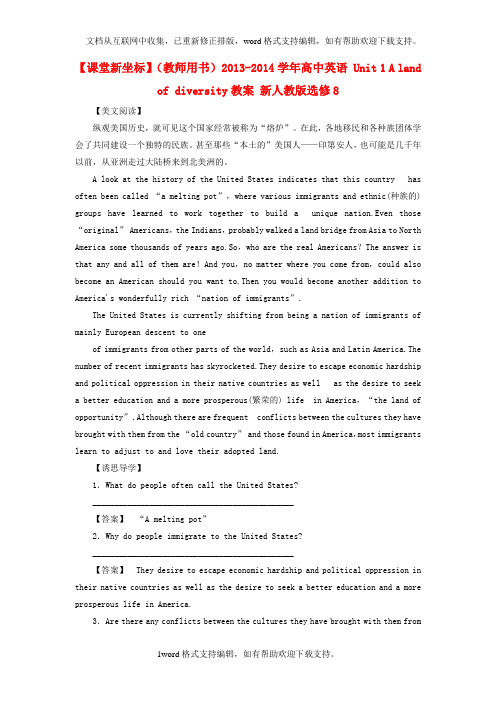
【课堂新坐标】(教师用书)2013-2014学年高中英语 Unit 1 A land of diversity教案新人教版选修8【美文阅读】纵观美国历史,就可见这个国家经常被称为“熔炉”。
在此,各地移民和各种族团体学会了共同建设一个独特的民族。
甚至那些“本土的”美国人——印第安人,也可能是几千年以前,从亚洲走过大陆桥来到北美洲的。
A look at the history of the United States indicates that this country has often be en called “a melting pot”,where various immigrants and ethnic(种族的) groups have learned to work together to build a unique nation.Even those “original” Americans,the Indians,probably walked a land bridge from Asia to North America some thousands of years ago.So,who are the real Americans?The answer is that any and all of them are!And you,no matter where you come from,could also become an American should you want to.Then you would become another addition to America's wonderfully rich “nation of immigrants”.The United States is currently shifting from being a nation of immigrants of mainly European descent to oneof immigrants from other parts of the world,such as Asia and Latin America.The number of recent immigrants has skyrocketed.They desire to escape economic hardship and political oppression in their native countries as well as the desire to seek a better education and a more prosperous(繁荣的) life in America,“the land of opportunity”.Although there are frequent conflicts between the cultures they have brought with them from the “old country” and those found in America,most immigrants learn to adjust to and love their adopted land.【诱思导学】1.What do people often call the United States?______________________________________________【答案】“A melting pot”2.Why do people immigrate to the United States?______________________________________________【答案】They desire to escape economic hardship and political oppression in their native countries as well as the desire to seek a better education and a more prosperous life in America.3.Are there any conflicts between the cultures they have brought with them fromthe “old country” and those found in America?______________________________________________【答案】Yes,there are.Period ⅠPreviewing(教师用书独具)●教学目标本课时主要是通过学生对学案所给出的内容的学习,了解本课文中所出现的词汇,初步了解课文以及相关的背景知识,为下一堂课对课文的全面理解起到一个铺垫作用。
新人教版高二英语选修八Unit 1 A land of diversity 各课时教案
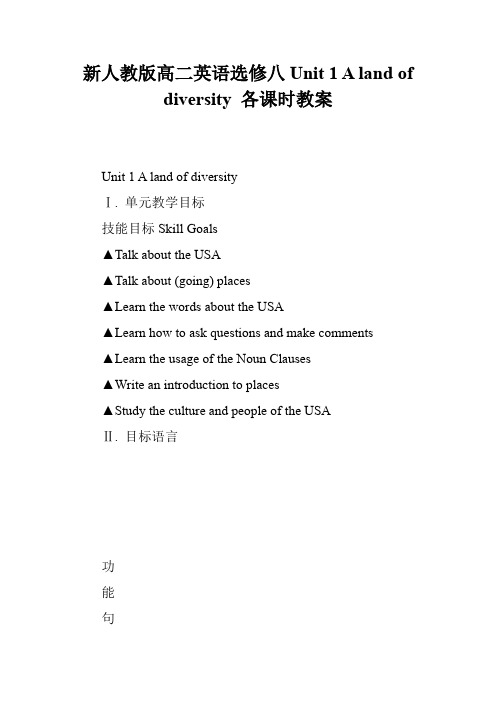
新人教版高二英语选修八Unit 1 A land of diversity 各课时教案Unit 1 A land of diversityⅠ. 单元教学目标技能目标Skill Goals▲Talk about the USA▲Talk about (going) places▲Learn the words a bout the USA▲Learn how to ask questions and make comments▲Learn the usage of the Noun Clauses▲Write an introduction to places▲Study the culture and people of the USAⅡ. 目标语言功能句式Talk about (going) placesWhere have you visited recently?When did people first live there?What is the climate like?Why is it so warm / cold / dry / wet there?What’s the population of...?How many nationalities live there?What did you think about the people?What is the most important festival there?How do they celebrate it?What other interesting things did you see?That’s interesting / terrific / marvelous / cool / lovely / beautiful, wonderful!You’re exciting / wonderful. Good / Creative /Fantastic / Super job!词汇1.四会词汇Strait distinct Arctic means majority ministry Catholic hardship elect federal rail percentage Italy Denmark boom aircraft Korea Korean Pakistan immigration racial crossing vice nephew pole applicant customs socialist occur cattle indicate luggage shave tram apparent apparently brake conductor slip bakery ferry hire seagull angle nowhere punishment justice mourn civil authority reform grasp thankful insert2.认读词汇illustrate, Alaska, prehistoric, immigrant, Hollywood, Laotian, conqueror, cable, Andrew, wharf, Alcatraz3.词组Live on, the Arctic, by means of, make a life, keep up, back to back, team up with, mark out, take in a great/good many, apply for结构Learn to use the Noun Clauses重点句子1. However, it is likely that Native Americans were living in California... P22. Of the first Spanish to go to..., the majority were... P23. That is why... P24. Some died or returned home, but... P25. Although Chinese immigrants..., it was the building of... P26. It is believed that before long... P37. Built in 1873... was invented by... P88. It’s a... that takes in... P89. He was noticed by... and to find... P5110. He spoke publicly about..., using his fame to help... P51Ⅲ. 教材分析和教材重组1. 教材分析本单元以“地域文化”为主题, 旨在通过单元教学,使学生了解有关美国地理方面的知识;学习加利福尼亚州的简介,使学生对美国的文明史略见一斑;通过阅读名人传记,研究美国的民族文化,使学生对美国有全方位的认识,掌握有关美国的历史、地理、文化、民族等方面的词汇;学会运用名词性从句等语法知识,并通过相关练习,提高学生的语言运用能力;通过阅读一篇图文并茂的美国游记,学会书写电子邮件或明信片,介绍某一名胜古迹和人文景观;通过学习、探究我国少数民族地区的多种文化,以及撰写我国某一城市、省份或地区的简介,加深对祖国地域文化的了解,提高写作能力。
人教版高中英语选修八教案:Unit1.doc

Book 8 Unit1精美句子1、善思则能“从无字句处读书”。
读沙漠,读出了它坦荡豪放的胸怀;读太阳,读出了它普照万物的无私;读春雨,读出了它润物无声的柔情。
读大海,读出了它气势磅礴的豪情。
读石灰,读出了它粉身碎骨不变色的清白。
2、幸福幸福是“临行密密缝,意恐迟迟归”的牵挂;幸福是“春种一粒粟,秋收千颗子”的收获. 幸福是“采菊东篱下,悠然见南山”的闲适;幸福是“奇闻共欣赏,疑义相与析”的愉悦。
幸福是“随风潜入夜,润物细无声”的奉献;幸福是“夜来风雨声,花落知多少”的恬淡。
幸福是“零落成泥碾作尘,只有香如故”的圣洁。
幸福是“壮志饥餐胡虏肉,笑谈渴饮匈奴血”的豪壮。
幸福是“先天下之忧而忧,后天下之乐而乐”的胸怀。
幸福是“人生自古谁无死,留取丹心照汗青”的气节。
3、大自然的语言丰富多彩:从秋叶的飘零中,我们读出了季节的变换;从归雁的行列中,我读出了集体的力量;从冰雪的消融中,我们读出了春天的脚步;从穿石的滴水中,我们读出了坚持的可贵;从蜂蜜的浓香中,我们读出了勤劳的甜美。
4、成功与失败种子,如果害怕埋没,那它永远不能发芽。
鲜花,如果害怕凋谢,那它永远不能开放。
矿石,如果害怕焚烧(熔炉),那它永远不能成钢(炼成金子)。
蜡烛,如果害怕熄灭(燃烧),那它永远不能发光。
航船,如果害怕风浪,那它永远不能到达彼岸。
5、墙角的花,当你孤芳自赏时,天地便小了。
井底的蛙,当你自我欢唱时,视野便窄了。
笼中的鸟,当你安于供养时,自由便没了。
山中的石!当你背靠群峰时,意志就坚了。
水中的萍!当你随波逐流后,根基就没了。
空中的鸟!当你展翅蓝天中,宇宙就大了。
空中的雁!当你离开队伍时,危险就大了。
地下的煤!你燃烧自己后,贡献就大了6、朋友是什么?朋友是快乐日子里的一把吉它,尽情地为你弹奏生活的愉悦;朋友是忧伤日子里的一股春风,轻轻地为你拂去心中的愁云。
朋友是成功道路上的一位良师,热情的将你引向阳光的地带;朋友是失败苦闷中的一盏明灯,默默地为你驱赶心灵的阴霾。
人教版选修8unit1教案

选修8(新课标人教版)教案英语组王宏波Help the students learn how to know the parts of speech according to the suffixes.Teaching important pointsGet the students to know the word about the USA.Teaching difficult pointsGet the students to know the word formation by adding suffixes.Teaching methodsStudy individually, practice in groups.Teaching aidsA computer and a recorder.Teaching procedures & waysStep Ⅰ RevisionAsk the students to discuss the question in Activity 3 on page 3, trying to explain the reasons in their own words and write 3 ~ 4 sentences. Ask them to share their answers and show their opinions.Step Ⅱ SuffixationFirst, ask the students to show their collected suffixes. Ask them to review the function of verbs, nouns and adjectives. And then ask them to fill in the charts with the proper forms of the words by practicing Activity 1 on page 4. At last, check the answers with the whole class.Step III Homework1. Ask the students to finish Activities 1-3 on page 48 in the workbook.2. Ask the students to prepare for the grammar about the Noun Clauses.The Third Period GrammarTeaching goals1. Target languageThe Noun Clauses, occur to2. Ability goalsEnable the students to identify the different types of the Noun Clauses and learn to use them.3. Learning ability goalsHelp the students learn how to use the Noun Clauses.Teaching important points Enable the students to use the Noun Clauses.Teaching difficult pointsEnable the students to distinguish different types of noun clauses.Teaching methodsComparing and practice.Teaching aidsA projector, a computer and a blackboard.Teaching procedures & waysStep Ⅰ RevisionCheck the homework.Step Ⅱ PresentationAt first, get the students to know what a noun clause is and what role it plays in the sentences. Then, discuss noun clauses as objects. Next, give them an example to show what are Noun Clauses and in what situations they should use them. At last show them the sentence structures of the Noun Clauses.Show the following.· That-clauses:I believe that you can learn noun clauses well.· If / whether clauses:The teacher must determine if / whether they are ready to study noun clauses.· Wh-clauses begin with words like who, what, how, whenever, which, etc:First you need to explain what a noun clause is.I know how I can make you learn noun clauses.Step Ⅲ PracticeAsk the students to practice Activities 1~4 on page 5. For Activities 1~2, discuss what role these clauses play in the sentences in pairs. For Activity 3, ask them to make sentences containing noun clauses on their own. For Activity 4, complete the dialogue with the given sentences in pairs. At last, check the answers with the whole class.Go on with the Activities 2-4. Then check the answers with the students.Step IV HomeworkAsk the students to do the following.1. Finish Activity 2 on page 49 in the workbook.2. Sum up all the conjunctions used with noun clauses and compare it with the conjunctions used with attributive clauses. Then tell the differences between them. Practice Activity 2 on page 49 (Workbook).3. Prepare for the “Using Language” part on pages 6~9 and surf the Internet to find the related information.The Fourth Period Integrating skills(Ⅰ)Teaching goals1.Target languagea. 重点词汇和短语luggage, tram, apparent, apparently, slip, bakery, ferry, hire, seagull, insert, react, team up with, mark out, take in, a great / good manyb. 重点句式Talk about traveling to some placesWhere have you visited recently?What is the climate like?What did you think about the people?What other interesting things did you see?That’s interesting / te rrific / marvelous / cool / lovely!You’re exciting / excellent.Good / Creative / Fantastic / Super job!2. Ability goalsEnable students to talk about places and learn to write an email or a postcard.3. Learning ability goalsHelp students learn how to talk about places and learn to write an email or a postcard.Teaching important pointsHow to talk about places.Teaching difficult pointsHow to write an email or a postcard.Teaching methodsListening, speaking and discussion.Teaching aidsA projector, a computer and a recorder.Teaching procedures & waysStep Ⅰ RevisionCheck the homework.Step Ⅱ Listening and speakingListeningAsk the students to listen to a conversation about the George’s tour around California. Then ask them to practice Activities 1~4 on pages 6~7. For the first time, ask the students to number the things they talk about.Check the answers by asking some students to read the completed postcard.Ask the students to listen to the tape and discuss the questions in pairs and write some of the things Christie says in pairs.SpeakingFor Activity 5, let them discuss in groups of 4 and later ask some of them to give their opinions. Step Ⅲ ReadingAsk the students to look at the given photos and read the George’s diary on pages 8 quickly. Then practice Activity 1 and fill in the chart in pairs.Ask the students to check the answers with their partners.For Activity 2, ask students to rea d the George’s diary on page 8 carefully and then answer the questions in pairs. Check the answers with the whole class.Ask the students to read the diary again by themselves. Then discuss in groups of 4 and practice Activities 3~4. A few minutes later, ask some of them to show their work.Sample answers:Reasons for omitting:1. Some unimportant, unnecessary, uninteresting little words like pronouns “we”, “I”, articles “a”, “the”, or prepositions. If omitted, the meaning can’t be affected and misunderstoo d by others.2. Just keep the key words without explaining more in details.Step Ⅳ HomeworkAsk the students to finish Activity 5 on page 9.The Fifth Period Extensive readingTeaching goals1. Target languagea. 重点词汇和短语consider, achievement, personality, enthusiastic, autobiography, musician, recording, trumpet, funeral, ceremony, coffin, march, ceremonyb. 重点句子He was noticed by... called... who... to teach... and to find...He spoke publicly about..., using his fame to help...2. Ability goalsEnable the students to find the topic of each paragraph and find the clue to show the important events.3. Learning ability goalsHelp the students learn how to find the topic of each paragraph and find the clue to show the important events.Teaching important pointsHow to find the clue to show the important events.Teaching difficult pointsHow to find the topic of each paragraph.Teaching methodsSkimming, scanning and discussion.Teaching aidsA recorder, a computer and a projector.Teaching procedures & waysStep Ⅰ RevisionCheck the homework by asking some students to show their work.Step Ⅱ Listening (Ⅰ)First, ask the students to listen to the tape and complete the notes. Check the answers by asking some students to read their notes.Then get them to discuss the questions in Activity 2 and talk about New Orleans.Ask the students to tick the boxes in Activity 3 and complete Activity 4; complete the activities after listening again.Then check the answers with the whole class.Step ⅢPre-readingT: “You can’t play anything on modern trumpet that doesn’t come from him. I can’t even remember a time when he sounded bad playing the trumpet. Never. Not even one time. He had great feeling up in his playing and he always played on the beat. I just loved the way he played and sang.” This is a comment about a jazz musician. Can you guess who the jazz musician was?S1: Louis Armstrong. I still think no one can beat Louis Armstrong and Chet Baker when it comes to trumpets, and when it comes to saxophone, Buddy Arnold is my fellow anything.T: What else do you know about him?S2: Louis Armstrong was the greatest of all Jazz musicians.S3: Armstrong defined what it was to play Jazz. His amazing technical abilities, the joy and spontaneity, and amazingly quick, inventive musical mind still dominate Jazz to this day.T: He was the grandfather of jazz. He was very successful because he always thought, “What we play is life.” Today we’re going to learn more about the famous musician.Step ⅣReadingSkimmingAsk the students to read through the whole passage and then do Activity 1 on page 52 and discuss the main topic of each paragraph in groups of 4. At last, check the answers with the whole class. Show the following on the screen.ScanningFor Activity 2, get the students to read the text again and then work together with their partners to make a time c hart to show the important events in Louis Armstrong’s life. Give them a few minutes to fill in the form. Check the answers with the whole class.Show the following on the screen.Step Ⅴ Homework1. Ask the students to read the passage again after class and do Activity 3 and list the reasons why the writer says that Louis Armstrong was considered great.2. Ask the students to talk about and write about some places in China.The Sixth Period Integrating skills(Ⅱ)Teaching goals1. Target languagea. 重点词汇和短语nationality, location, geographical fractures, production, interview, cultureb. 重点句式Talk about placesWhen did people first live there?What’s the climate like?Why is it so warm/cold/dry/wet there?What’s the population of the city or province?How many nationalities live there?What is the most important festival there? How do they celebrate it?2. Ability goalsEnable the students to talk about and write about places.3. Learning ability goalsHelp the students learn how to talk about and write about places.Teaching important pointsHow to talk about places.Teaching difficult pointsHow to write about places.Teaching methodsDiscussion.Teaching aidsA projector, a computer and a recorder.Teaching procedures & waysStep Ⅰ RevisionCheck the homework. First ask the students to discuss Activity 3 in groups of 4. Then share the reasons why the writer says that Louis Armstrong was considered great.Step Ⅱ TalkingFor Activity 1 on page 47, ask the students to discuss a city or province in China that has amixture of different cultures in groups of 4, filling in the given chart and answering the questions in the textbook.Step Ⅲ Speaking and writing taskAsk the students to read the tips and steps given in the textbook and talk about a Chinese city, province or zone in groups of 4. Then ask them to write a description.Step Ⅳ Homework: ProjectAfter class, ask the students to study small pieces of the USA, its culture and its people and then put all the pieces together to form a more complete picture. In this project, each student should choose a different aspect of America to research and then present his or her information to the rest of the class. They can use the library or search for information on the Internet.Unit 2 CloningⅠ. 单元教学目标Skill GoalsTalk about cloningPractice expressing and supporting an opinionUse the appositive clauseWrite a composition about cloningⅡ. 目标语言功能句式Expressing and supporting an opinion I’m happy to accept... but...I would never accept... I’m not bothered about...I don’t mind but...I hope you’ll carry on...Are you sure you want to...? I agree with you that...Is it fair to...? Do you think it is wise to...?I think you should... Well done to you for... I don’t understand why you don’t...I can’t help thinking...I could never agree to...词汇四会词汇Differ exact twin commercial straightforward undertake breakthrough procedure carrier cast altogether arbitrary correction object objection medium obtain attain moral conservative forbid accumulate constitution compulsory opera chorus loaf flour owe shortly retire bother assumption regulation strike initial vain resist drawback merely decoration unable feather turkey claw adore hatch reasonable 2.词组cast down, object to, the media, in favour of,(be)bound to(do)..., from time to time, bring back to life, pay off, in vain结构:Appositive clause — that 可引导同位语从句重点句子:It is a way of... P11 The fact is that... P11The question that occurred ... P12 The advantage is that... P15The First Period ReadingStep I Lead-inLook at picturesT: Look at the pictures and discuss which ones are natural clones and which ones are man-made. Then explain how they differ.S: I think the twins are natural clones and the Dolly sheep is man-made.T: You are right! Can you explain how they differ?S: The twins were born at the same time, but the Dolly sheep is man-made.T: Anything else? Who want have a try?S: I think the identical dog is man-made.T: Good job!Step Ⅱ Pre-readingBefore class, ask the students to search for some information about this topic. Now show your questions on the screen, and then let them discuss with each other.Questions about cloning:1. What is a clone?2. How is a clone produced?3. What benefits can humans gain from cloning?4. What problems may arise when humans are cloned?5. Should we clone human?6. Could cloning replace sex as the means of creating new human life?7. Could a parent clone a child who is dying of a terminal illness?Suggest answers:1. It is a way of making an exact copy of another animal and plant.2. This happens in plants when gardeners take cuttings from growing plants to make new ones, and when small parts of a plant are taken and gown in a laboratory. It also happens in animals when twins identical in sex and appearance are produced from the same original egg.3. It can help cure disease and can help couples who have no baby to bear a new baby.4. There may be more bad people like Hitler.5. In my opinion, I do not agree, for it may cause many moral problems.6. No. Because cloned human has the same quality as the real human, natural born baby’s quality is higher than his parents.7. No. The cloned baby also has the disease.Step Ⅲ While-readingGet the students to comprehend the passage quickly and accurately and meanwhile help the students form a good habit of reading.divide the whole passage into several parts and find out the main idea of each part.Show the following.Para. 1 Cloning is a way of making an exact copy of another animal and plant.Para. 2 Cloning has two major uses.Para. 3 The problems of Dolly.Para. 4 The effect of Dolly.Para. 5 It is forbidden to clone human being.Step Ⅳ Post-readingAsk the students to read the passage again to finish three tasks.T: Now let’s listen to the tape. While listening, pay more attention to the correct pronunciation and tone. Then read the text by yourselves to get the answers to the three tasks. You can work in groups.T: First, what are the problems or dangers of cloning?S: Let me have a try! First, the cloned animals have the same illness of the old animals and the same goes with the other species. Second, the cloned animals have short life and can cause moral questions.T: You are right! And what are the advantages of cloning?S: I know! Firstly, gardeners use it all the time to produce commercial quantities of plants. Secondly, it is valuable for research on new plant species and for medical research on animals. Third ly, it suddenly opens everyone’s eyes to the possibility of using cloning to cure serious illnesses, and even producing human beings.T: What is the writer’s opinion? What do you think is the writer’s point of view in this reading passage? Is it in favour of cloning or against it?S1: I think the writer is in favour of it, because there are many advantages of cloning. It can help people solve many problems in our daily life.S2: I think the writer doesn’t agree with it, because if the cloning technology can be used in an evil way, it can cause much trouble to our society.T: The next question: What is your opinion of cloning? Give the reasons.S1: As a coin has two sides, everything has two aspects. First, if the cloning is used in a correct way it can bring many conveniences to us. Such as: curing serious illnesses and being used to produce commercial qualities of plants. On the other hand, if the cloning is used in an evil way it can cause much troubles: such as moral questions.S2: My view on cloning and nuclear transfer is that it is ethical. So actually I find no reason to clone presently. I have this opinion currently, because scientists are unable to successfully clone using nuclear transfer as of today.Step Ⅴ HomeworkAsk the students to do the following.1. Complete the exercises on page 13.2. Recite the key sentences in the text.3. What is Clone? You might not believe it, but there are human clones among us right now. Have you ever wished you could have a clone of yourself to do homework while you hit the skate park or went out with your friends? Imagine if you could really do that. Where would you start?The Second Period ListeningStep I Revision1. Greetings2. RevisionStep Ⅱ Pre-listeningWork in groups to discuss how we should behave towards the human clones.T: Before human clones become part of our life, perhaps we should spend some time thinking about how we should behave towards them. Now, work in groups to discuss the followingquestions.Show the following.1. How would you treat human clones?2. Do you think they should have legal and political rights, such as getting married or voting?3. Do you think they are separate people or part of the original donor?Sample answers:1. I will treat them as normal people.2. Yes, I think they should have the legal and political rights.3. I think they are separate people.Step Ⅲ ListeningThe students are asked to read fast the questions and multiple answers to find out the listening points first, and then listen to the tape twice to choose the best answer.Step Ⅳ Listening task (P57)First, ask the students to read these sentences and then listen to the tape and decide if they are facts or opinions. Play the recording and then check the answers with the class.Sample answers:Arguments for cloning pets:1. Favorite pets can live forever as clones.2. It is moral to clone pets for their owners.Arguments against cloning pets:1. Many people don’t agree with cloning.2. Some people think that cloning pets is selfish.Step Ⅴ HomeworkT: Boys and girls, today we have listened to some materials about cloning. I do hope you can listen to the materials again after class so that you can get very familiar with them. Besides, please preview the reading. Now class is over. Goodbye, everyone.The Third Period SpeakingStep Ⅰ Lead-inStep Ⅱ Read and answer (P16)To answer these three questions, teacher can give the students some examples as explanation, for example, Question 1.T: Now think about this question: if in the world there is only one sheep and human beings want to clone more. Some days later a Dolly appears, then many more. But one day all sheep get the same deadly disease. Now please think about what the results are.S: Maybe they would all die.T: Why?S: Because all sheep have the same arrangement of genes.T: Right. Now can you answer Question 1? Why shouldn’t you clone an extinct animal unless there is enough diversity in the group?S: It is useless to clone an animal if there is not enough diversity in the group for it to overcome illnesses.T: Why is it wrong to clone an extinct animal if it would have to live in a zoo?S: If the cloned animals have to live in the zoo, it is unfair to them. They need freedom.T. Why can’t you clone the DNA of animals that have be en extinct longer than 10,000 years?S: Dinosaurs disappeared 65,000,000 yeas ago. So the chance of dinosaurs returning to the earth is merely a dream.Step Ⅲ Discussion (Question 2)This is a speaking task. Ask the students to have a discussion in groups, organize their words properly, and give vivid description of the chosen animals.T: Now look at the table on page 16, discuss in pairs which extinct animals described are worth restoring by means of cloning. Choose one animal and use the information to help you argue why this animal should be restored to the earth.Give the students six minutes to discuss.Step Ⅳ Writing a report (P17)Deal with Questions three and four. Divide the whole class into four groups. Then they can have a competition.T: Now everyone, imagine all of you are owners of your chosen animal. Now work together, and give us a vivid description of your pet, then I will decide which one is the best to be resorted to the earth.Several minutes later, the students give performances. At the same time, list some major points on the blackboard.T: Well done everyone. It is really hard for me to choose, let us vote OK?Step Ⅴ TALKING (P55)Ask the students to talk about the questions with the teacher’s help.T: Look at the questions on page 54. Do you know how to show your opinion? You can discuss the following questions with your partner and use these expressions on page 54.1. How would you feel about having a clone of yourself in the family?2. What problems did you have growing up and how can you help him / her avoid them.Step Ⅵ HomeworkT: Write down your feelings and attitudes towards clone. Combine them into a composition.The Fourth Period GrammarStep Ⅰ RevisionCheck the students’ homework.Step ⅡGrammarT: Do you know the appositive clauses? Please pick out three more examples from the reading passage.Sample answers:The fact is that they are natural clones of each other.The whole scientific would follow the progress of the first successful clone, Dolly the sheep. Altogether Dolly lived for six years, half the length of the life of the original sheep.T: Now let me explain something about the appositive clauses. The appositive clause is a clause used as an appositive. The clause is an explanation to the noun before. The appositive clause belongs to noun clauses. Most of the appositive clauses may be introduced by the conjunction that.A content clause is frequently in apposition with such nouns as fact, news, idea, thought, question, reply, report, remark, hope, belief, suggestion etc.Some examples:Nobody shares my belief that he was mad.My suggestion that he was mad was not accepted.They are familiar with the opinion that all matter consists of atoms.Where did you get the idea that I could not come?We haven’t yet settled the question where we are going to spend our summer vacation.The suggestion came from the chairman that the new rule should be adopted.T: The words the fact are often inserted in front of an object clause when the clause cannot be conveniently connected with the verb either directly or by means of the representative it.This cannot hide the fact that he is growing old.We must face the fact that we are living in a revolutionary world.Some supplements:同位语从句与that引导的定语从句1) 从先行词看同位语从句与名次之间在逻辑上是“主语+be+表语”的关系。
人教版选修八Unit1《Alandofdiversity》word教案
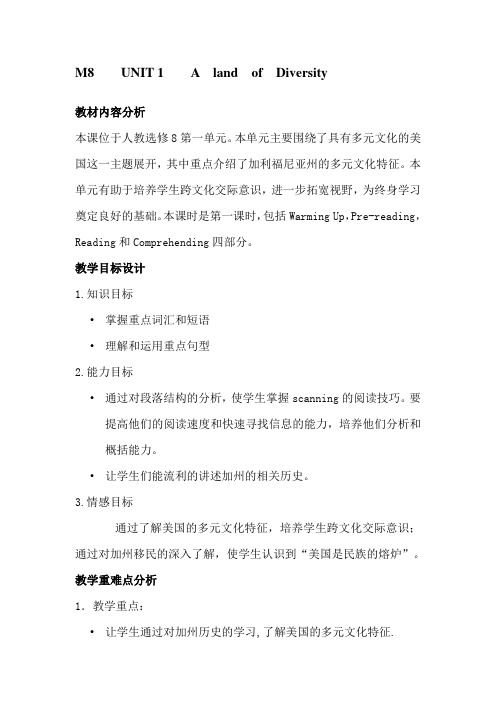
M8 UNIT 1 A land of Diversity教材内容分析本课位于人教选修8第一单元。
本单元主要围绕了具有多元文化的美国这一主题展开,其中重点介绍了加利福尼亚州的多元文化特征。
本单元有助于培养学生跨文化交际意识,进一步拓宽视野,为终身学习奠定良好的基础。
本课时是第一课时,包括Warming Up,Pre-reading,Reading和Comprehending四部分。
教学目标设计1.知识目标•掌握重点词汇和短语•理解和运用重点句型2.能力目标•通过对段落结构的分析,使学生掌握scanning的阅读技巧。
要提高他们的阅读速度和快速寻找信息的能力,培养他们分析和概括能力。
•让学生们能流利的讲述加州的相关历史。
3.情感目标通过了解美国的多元文化特征,培养学生跨文化交际意识;通过对加州移民的深入了解,使学生认识到“美国是民族的熔炉”。
教学重难点分析1.教学重点:•让学生通过对加州历史的学习,了解美国的多元文化特征.2.教学难点•帮助学生理解加州多元文化形成的原因。
教学方法新课改不仅注重知识的传授,也注重学生能力及情感态度价值观的培养。
根据教学内容及学生实际,我主要采用以下教学法:1.任务型教学法本课选择任务型教学,如要求学生课前预习阅读文章,课堂进行小组讨论,填写信息表等,培养和强化学生的语言实践能力和自主学习能力。
2.多媒体辅助教学法利用多媒体展示相关图片,激发学生学习兴趣,提高课堂教学效率。
教学过程1. Warming up2. Pre-reading3. Reading(1) Skimming(2) Detailed reading4. Discussion5. Language points focus6. Questions time7.Summary8. Homework学习流程Before class (课前自主学习,合作探究)------- Vocabulary(词汇预习)------- Preview the new words of this text.【设计意图】通过预习词汇为下一步的阅读扫清生词障碍。
高中英语人教版选修8Unit1Alandofdiversity教学设计
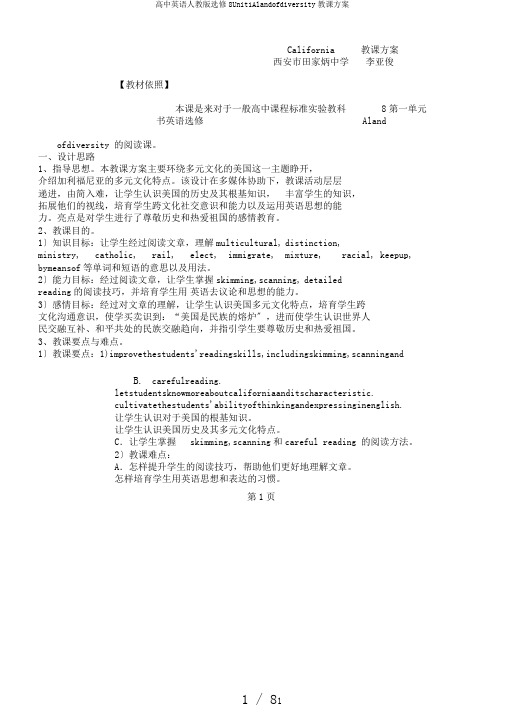
California 教课方案西安市田家炳中学 李亚俊【教材依照】8第一单元Aland本课是来对于一般高中课程标准实验教科书英语选修 ofdiversity 的阅读课。
一、设计思路1、指导思想。
本教课方案主要环绕多元文化的美国这一主题睁开,介绍加利福尼亚的多元文化特点。
该设计在多媒体协助下,教课活动层层递进,由简入难,让学生认识美国的历史及其根基知识, 丰富学生的知识,拓展他们的视线,培育学生跨文化社交意识和能力以及运用英语思想的能力。
亮点是对学生进行了尊敬历史和热爱祖国的感情教育。
2、教课目的。
1〕知识目标:让学生经过阅读文章,理解multicultural, distinction,ministry, catholic, rail, elect, immigrate, mixture, racial, keepup, bymeansof 等单词和短语的意思以及用法。
2〕能力目标:经过阅读文章,让学生掌握skimming,scanning, detailedreading 的阅读技巧,并培育学生用 英语去议论和思想的能力。
3〕感情目标:经过对文章的理解,让学生认识美国多元文化特点,培育学生跨文化沟通意识,使学买卖识到:“美国是民族的熔炉〞,进而使学生认识世界人民交融互补、和平共处的民族交融趋向,并指引学生要尊敬历史和热爱祖国。
3、教课要点与难点。
1〕教课要点:1)improvethestudents'readingskills,includingskimming,scanningandB. carefulreading.letstudentsknowmoreaboutcaliforniaanditscharacteristic.cultivatethestudents'abilityofthinkingandexpressinginenglish.让学生认识对于美国的根基知识。
人教课标版高中英语选修8 Unit1_Learning_about_Language_名师教学设计
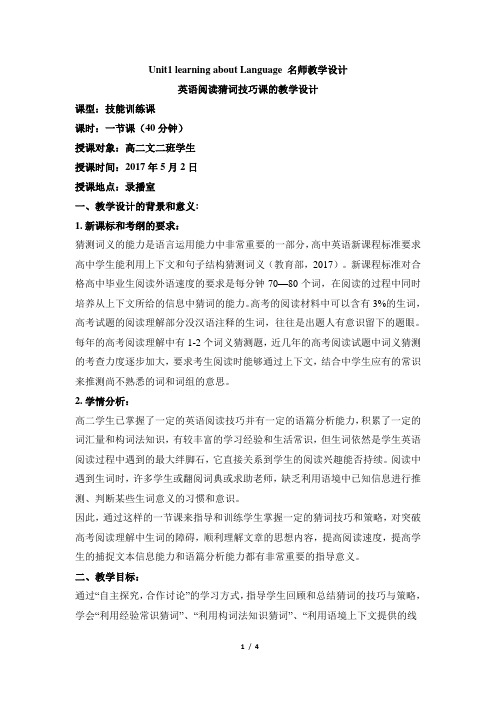
Unit1 learning about Language 名师教学设计英语阅读猜词技巧课的教学设计课型:技能训练课课时:一节课(40分钟)授课对象:高二文二班学生授课时间:2017年5月2日授课地点:录播室一、教学设计的背景和意义:1. 新课标和考纲的要求:猜测词义的能力是语言运用能力中非常重要的一部分,高中英语新课程标准要求高中学生能利用上下文和句子结构猜测词义(教育部,2017)。
新课程标准对合格高中毕业生阅读外语速度的要求是每分钟70—80个词,在阅读的过程中同时培养从上下文所给的信息中猜词的能力。
高考的阅读材料中可以含有3%的生词,高考试题的阅读理解部分没汉语注释的生词,往往是出题人有意识留下的题眼。
每年的高考阅读理解中有1-2个词义猜测题,近几年的高考阅读试题中词义猜测的考查力度逐步加大,要求考生阅读时能够通过上下文,结合中学生应有的常识来推测尚不熟悉的词和词组的意思。
2. 学情分析:高二学生已掌握了一定的英语阅读技巧并有一定的语篇分析能力,积累了一定的词汇量和构词法知识,有较丰富的学习经验和生活常识,但生词依然是学生英语阅读过程中遇到的最大绊脚石,它直接关系到学生的阅读兴趣能否持续。
阅读中遇到生词时,许多学生或翻阅词典或求助老师,缺乏利用语境中已知信息进行推测、判断某些生词意义的习惯和意识。
因此,通过这样的一节课来指导和训练学生掌握一定的猜词技巧和策略,对突破高考阅读理解中生词的障碍,顺利理解文章的思想内容,提高阅读速度,提高学生的捕捉文本信息能力和语篇分析能力都有非常重要的指导意义。
二、教学目标:通过“自主探究,合作讨论”的学习方式,指导学生回顾和总结猜词的技巧与策略,学会“利用经验常识猜词”、“利用构词法知识猜词”、“利用语境上下文提供的线索和标志词找寻信息猜词”,提高学生利用语境猜词的意识和能力。
三、教案设计I 教学目标Knowledge and skills知识与技能1. Acquire the techniques and strategies of word-guessing2. Use the techniques and strategies of word-guessing learnt to solve the problems. Emotion, attitude and values 情感态度价值观1. Build up confidence in guessing new words while reading2. Increase the awareness of guessing new words in reading discourses depending on t he context and enhance the skills in use.II教学重点与难点Teaching focus:1. Search for the clues and hints in the context that reveal the techniques of word-gues sing.2. Sum up the ways and the techniques to guess new words.III教学方法Communicative Approach,cooperative-learning,Inquiry-based learning,Autonomous learning,Individual work,Group discussionIV教学过程设计Teaching Procedures:Step1. A guessing game1.Prepare some papers and write one word on each paper before class.2.Divide students into two groups and choose three students from each group. One to act out the word using body language or English descriptions. One to write down the word on the blackboard. One to hold up the paper. The others in the group to guess the word.The more the better in 2 minutes.3.Ask the students a question: “When you meet a new word while reading, what would you do, ignore it, look it up in the dictionary or guess?”4. Lead in the topic of the class:How to Guess the Meaning in Reading.Step2.Reading and discussing1.Students work in groups to do some exercises.2.Cooperate in groups and inquire some ways to guess the meaning of each unknown word according to the given contexts.3.Students sum up the ways with the help of the teacher and through inquiring-learnin gStep3. Analyzing and discoveringStudents activity【课堂活动】1.Work in groups and observe the following sentences, predict the meaning of each un known word depending on contexts, and try to discover the key words (clues and hint s hidden) in the context.2.Present what the group discover and recommend the next group to continue the pres entation.3.Teacher adds and extends more informationStep4. Summarizing the rules1. Teacher and students to summarize the six ways of guessing the words.To guess the words correctly we can use the context clues:①Use synonym(同义词) Context Clues②Use Antonym(反义词) Context Clues③Use definition/ example/description clues(文中的定义或解释说明)④ Use common sense/related information clues(常识和经验)⑤Use grammar and punctuation clues(标点符号或提示词)⑥Use causes and effects relations(因果关系)⑦Use transition and contrast clues(转折和对比关系)⑧Use word-building(构词法)Step 5. Practice and consolidation1. Ask the students to do some exercises in class.2. Let the students check the answers with their partners and discuss how they finish them.3. Check the answers with the whole class one by one and point the ways of doing the exercises out for the students.Step 6. Emotion motivation.1.Words,like people,are frequently known by the company they keep.A word’s contex t or surroundings can provide clues to meanings.2.Unfamiliar words is to English reading is like what setbacks is to our life.No matter what difficulties you come across in your life, remember that as long as yo u don’t lose heart, you are sure to find a way out.3.Where there is a will, there is a way.Step 7. Homework1.Review what we learned today.2.Finish the related exercises..教学反思:本节课的设计符合高二学生的学情,以学生为本,指导学生归纳总结猜测词义的技巧与策略,提高学生利用语境猜词的意识和能力。
人教版高中英语选修8 Unit1 A land of diversity 教案新部编本

教师学科教案[ 20 – 20 学年度第__学期]任教学科:_____________任教年级:_____________任教老师:_____________xx市实验学校选修8 Unit 1 A land of diversity闽侯六中——林锦安Period 1 ReadingTeaching goals1.Enable the students to talk about things about the USA.2.Help the students learn the huge diversity of races and cultures in America, especially inCalifornia.Teaching important and difficult pointsLearn the huge diversity of races and cultures in California.Teaching methodsFast and careful reading; asking and answering activity; individual, pair or group work. Teaching aidsA map, a blackboard and a computerTeaching proceduresStep 1 Warming up.1.Ask the students to describe what they learn about the USA.2.Group work: look at the map of the USA with your group. Write on the map the names of asmany of the following as you can. Compare your names with other groups.Step 2 Pre-reading1.Ask the students to tell things about California including its location, size, population,economy, history etc. What do you learn about California?2.Show the students some pictures and encourage students not only to say what each picture isabout but how each one relates to California.Step 3 Fast reading1.Read through the passage and get the main idea.2.Reading comprehension.Ask the students the following questions:1)When you look at the title, what so you think of ?A land of differences. California is a land of great differences — differences in climate, in landscape and attitude.2) Why is the USA called a melting pot?There are many immigrants to the USA and there are many cultures and nationalities. So it is a place in which people, ideas, etc of different kinds gradually get mixed together.3.Beside each date note down an important event in Californian history.Step 4 Detail readingBeside each cultural group , write the period in which they first came to California in largeStep 5 After readingWhy is California in the 21st century such a multicultural community? (Using 3 or 4 sentences to explain. )Step 6 HomeworkFinish “Learning about language”on page 4.Period 2 Extensive ReadingTeaching aims: 1. Improve Ss’ ability of reading2. 德育目标:了解美国多元文化,进一步培养学生跨文化交际意识,为终身学习奠定良好基础。
人教版高中英语选修八全册教案
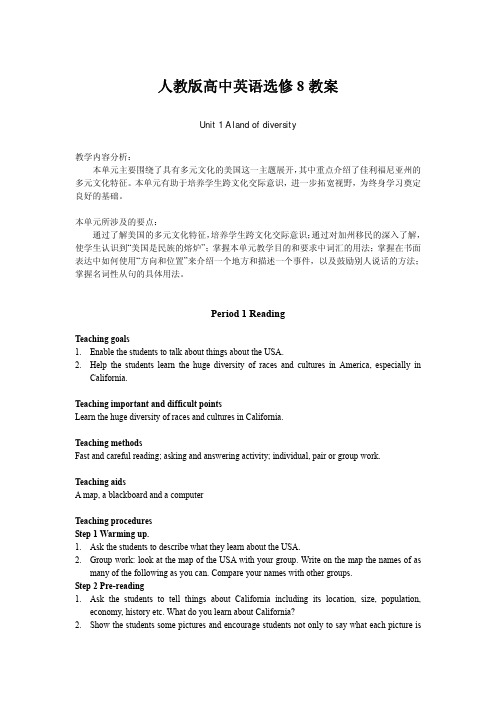
translate the following sentences
1) War was declared on the enemy.
2) She declared that she knew nothing about it.
3) Have you anything to declare.
declare oneself
Step 5 Homework
Review the language points.
Period 3 Grammar
Teaching aims 1. Enable the students to use the Noun Clauses as the subject, object, predicative and oppositive. 2. Help the students learn how to use the Noun Clauses.
There are many immigrants to the USA and there are many cultures and nationalities. So it is a place in which people, ideas, etc of different kinds gradually get mixed together. 3. Beside each date note down an important event in Californian history.
选修8unit1教案

选修8unit1教案教案标题:选修8 Unit 1 教案- 探索潜水教学目标:1. 了解潜水的基本概念和技能;2. 掌握潜水所需的基本装备和安全措施;3. 学习并运用相关词汇和语法结构;4. 培养学生的合作和团队合作能力。
教学重点:1. 潜水的基本概念和技能;2. 学习并应用相关词汇和语法来描述潜水活动;3. 培养学生的合作与沟通能力。
教学难点:1. 学生的听说能力的提高;2. 语法结构的正确运用;3. 培养学生的团队合作意识。
教学准备:1. 电子白板或投影仪;2. 单词卡片和图片等教具;3. 多媒体教学资料。
教学过程:一、导入(5分钟)1. 利用多媒体图片或视频展示潜水的场景,激发学生对潜水的兴趣;2. 出示一幅潜水装备的图片,让学生猜测图片内容,引入潜水话题。
二、知识传递与技能训练(30分钟)1. 分组讨论:学生分组探讨并汇报他们对潜水的认识和了解;2. 教师通过多媒体展示PPT,介绍潜水的基本知识、技能和安全措施;3. 基于学生的年龄和水平,设计合适的听力和口语练习,让学生能在实际情境中应用所学知识;4. 导入重点词汇,如“scuba diving”、“underwater”、“diving gear”等,进行词汇教学。
三、语言应用与巩固(15分钟)1. 学生练习使用相关词汇,描述潜水的过程和体验;2. 教师设计角色扮演活动,让学生扮演潜水教练和学员的角色,进行对话练习;3. 引导学生运用所学语法结构,如动词时态和疑问句等,构建具有逻辑连贯性的对话。
四、拓展与实践(15分钟)1. 学生小组合作,设计一个拓展学习的任务,如制作海报、PPT等,展示他们对潜水的深入了解;2. 分享学生的任务成果,并进行互动交流,加深对潜水知识的理解;3. 教师对学生的表现给予肯定和鼓励,激发学生的学习热情。
五、作业布置(5分钟)要求学生撰写一篇短文,描述他们对潜水的认识和理解,体验过程以及感受,并指导他们运用所学语法和词汇。
高中英语 Unit1第1课时 The First Period Reading教案 新人教版选修8
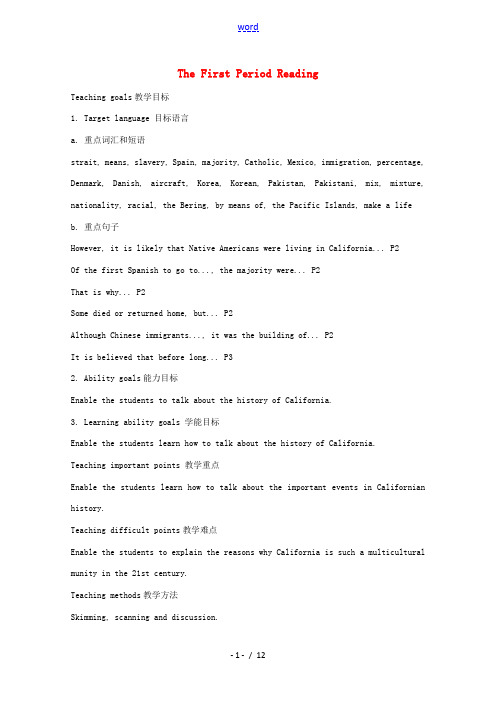
The First Period ReadingTeaching goals教学目标1. Target language 目标语言a. 重点词汇和短语strait, means, slavery, Spain, majority, Catholic, Mexico, immigration, percentage, Denmark, Danish, aircraft, Korea, Korean, Pakistan, Pakistani, mix, mixture, nationality, racial, the Bering, by means of, the Pacific Islands, make a life b. 重点句子However, it is likely that Native Americans were living in California... P2Of the first Spanish to go to..., the majority were... P2That is why... P2Some died or returned home, but... P2Although Chinese immigrants..., it was the building of... P2It is believed that before long... P32. Ability goals能力目标Enable the students to talk about the history of California.3. Learning ability goals 学能目标Enable the students learn how to talk about the history of California.Teaching important points 教学重点Enable the students learn how to talk about the important events in Californian history.Teaching difficult points教学难点Enable the students to explain the reasons why California is such a multicultural munity in the 21st century.Teaching methods教学方法Skimming, scanning and discussion.Teaching aids教具准备A recorder, a puter, a projector and some pictures.Teaching procedures & ways教学过程与方式Step Ⅰ Lead-inT: Boys and girls, we’ve learned English s everal years. We know that English is mainly used in England, Australia, the United States of America, etc. And we’re now learning American English. But how much do you know about the United States of America — a land of diversity? As we all know, the US is a world power with the most developed economy. It lies in the North America, bordering both the North Atlantic Ocean and the North Pacific Ocean, between Canada and Mexico. There are fifty states in the US. Forty-eight of them are in the single region between Canada and Mexico; this group is referred to, as the continental or contiguous United States. Two of the 50 states, Alaska (a state in northwestern North America) and Hawaii (a state in the central Pacific on the Hawaiian Islands), are not contiguous with any of the other states. In the past few years, we’ve seen or heard many of the world’s events which have something to do with the US, such as the September 11 attacks, Iraqi war, Kartrina Hurricane, etc. Today we are going to learn more about this powerful country. First, look at the following pictures.Show some pictures on the screen.T: All right. Now please tell me what you know about them? Who wants to have a try? S1: The American flag is the Star - Spangled Banner. There are 50 stars with whiteand red strips on the rest of the flag.S2: The stars stand for 50 states. The red color symbolizes courage; the white symbolizes freedom and the blue means loyalty and justice.S3: The White House is the executive mansion of the President of the United States. The American President lives and works in the building.S4: There are many important places in it, such as the pressroom and the oval office. S5: The Statue of Liberty is standing on a small island in New York Harbor.S6: In 1886, French sent it as a gift for American Independence Day on her 100th anniversary.S7: The crowned lady is 46 meters high, with a torch in her right hand holding aloft and Declaration of Independence in her left.S8: For a century, the Liberty has been standing on the Island proudly symbolizing the spirit of independence of the USA.T: Very exactly. What else do you know about the USA?S9: A federal republic, United States of America is posed of a federal district, Washington DC and 50 states. All the states except for Hawaii islands are situated in mainland America.S10: It has a population of about 2,900 million. Its area is 9,370,000 sq km.S11: The climate of USA is mainly temperate in nature but in Hawaii and Florida, it is tropical.S12: The language they mainly use is English.Step Ⅱ Warming upAsk the students to turn to page 1 and look at the map of the USA and talk about it in groups of 4.Fill in the given form. Then write on the map the names of the oceans, countries, mountain ranges, lakes, rivers and big cities. At last, check the answers with thewhole class.T: Good job! Do you want to learn more knowledge about the USA? Now please open your books and turn to page 1. Here is a map of the USA. Please look at it carefully. Try to write on the map the names of the oceans, countries, mountain ranges, lakes, rivers and big cities.Oceans Countries Mountain Ranges LakesRivers Cities East West North South West East Huron,Ontario,Michigan,Erie,SuperiorMississippi Washington New York,Angeles, Chicago, Houston, Philadelph Miami, Atlanta, San FranciPacific Atlantic Canada Mexico Cascade, Coast, Brook, Alaska,RockyAppalachianStep Ⅲ Pre-readingT: Can you find the location of California? Where does it lie?S1: Yes, it is lying on the Pacific Ocean in the west and on Mexico in the south. S2: California is on the west coast of the United States, which is diverse in topography, climate and ecological environment.T: Correct. Anything else do you know about the state?S2: It has an area of 411 square kilometers. And it is one of the American states of the largest population, with the most developed economy.S3: You are right. Its economy takes the first place among all the states. So it’s one of the most important states.S4: The pleasant weather, long beach and graceful natural landscape make the tourism prosperous.T: Well done! Just as people go to the USA from many places today, so did in ancient times. Today we’re going to learn the short history of California. Now please look at the pictures about California. And discuss in groups of 4 what each picture means to you. A few minutes later, I’ll ask some of you to say something about them.A few minutes later.T: OK, now I’d like some of you to say something about the pictur es.S1: I can see a Native American farmer in the left picture on page 1. He was standing beside a camp in the forest. It seemed that he felt very happy. Maybe he had a good harvest.S2: The villagers moved to these various camps in the forests during the harvest season, depending on the type of crop being gathered.S3: In the middle picture, a man was panning gold. He looked not only thin and weak, but also thirsty and tired.S4: I think it was difficult for them to achieve the dream of being rich.S5: He might have to give up, leave California and go back home.S6: The right picture illustrates modern California with beautiful buildings and busy street.S7: By 1990, the nations being immigrated from different parts of the world had made California into the most racially and ethnically diverse state in the country. S8: The picture on page 2 shows us a Spanish religious man.S9: The picture on page 3 shows us Indian children were allowed to attend public schools.S10: The number of African Americans in California increased dramatically following the turn of the 20th century.Step Ⅳ ReadingScanningAsk the students to read the text silently and then ask some questions about the text. T: Today we’re going to read a short history of western painting. Now let’s read it quickly and find out the answers to the questions on the screen with your partners. Show the questions on the screen.1. Who were the first to arrive in California to rush for gold?2. When and why did the large number of Chinese immigrate to California?3. What attracted people from different parts of the world to immigrate to California? T: Now who can answer Question 1?S1: South Americans and people from the United States.T: Good! Who’d like to answer Question 2?S2: During the Gold Rush Period, many Chinese immigrated to California to achieve their dream of being rich.S3: In the 1860s, a large number of Chinese went there to build the railway from the west to east coast.T: Exactly. How about the third question?S4: I think the temperate climate attracted immigrants to California.S5: Maybe the modern lifestyle there is more attractive to people from other parts of the world.T: Good job!SkimmingIn this part, the students will read the text again and try to get the main idea in groups of 4. Then show the following form on the screen. Give them a few minutes to fill in the form. Then check the answers with the whole class.T: Now please read the text again. And then let’s try to get the main idea of the text. I’ll show the form on the scr een and give you a few minutes to fill in it. Show the form with blanks on the screen.CALIFORNIAStage People Time EventNative Americans Asians 15,000 Arrived first Natives 1600s Suffered byEuropeansSpanish Spanish 1600s Took native’s landRuled by Spain1800s Became part ofMexico1821 Declared war &Given back1846 Settled in Russians Russians 1800s Settled inGold miners South 1848 Discovered & RushAmericans Americans, Europeans, Asiansfor gold1850 Became a stateAfricans 1800s Moved from Mexico Chinese 1860s Built the railway Japanese Early 1900 FarmedDenmark 1911 Established a town Jewish By 1920s Developed industry Italians Late 1900s Fished and madewineAfricans 1942~1945 Worked in ship &aircraftindustriesRecent arrivals Indians,Pakistanis 1970s Worked in puterindustryCambodians, Koreans, Vietnamese, Laotians RecentdecadesImmigratedFuture Different parts Future ImmigratedExplanationT: Now let’s deal with some language points in the te xt. Look at the sentences on the screen. Who can explain the sentences?Show the following.1. However, it is likely that Native Americans were living in California... P22. Of the first Spanish to go to..., the majority were... P23. That is why... P24. Some died or returned home, but... P25. Although Chinese immigrants..., it was the building of... P26. It is believed that before long... P3Step Ⅴ prehendingAsk the students to read the passage again and try to know more about the pictures, the people and the events in different history periods. First ask students to practice Activities 1-3 in pairs. And then check the answers with the whole class.T: Read the passage again. Now I’d like you to practice Activity 1.S1: The first picture on page 2 shows us some life-styles of the Native Americans in California. Native Americans first arrived and have lived in California for thousands of years.S2: They established their homes along the central California coast long before the Europeans arrived.S3: They suffered a lot by Europeans, thousands were killed or forced into slavery. S4: The middle picture on page 2 is about the Gold Rush in California.S5: One of the largest human migrations in history as a half-million people from around the world descended upon California in search of instant wealth.S6: Many died or returned home, but most of them remained in California.S7: The right one shows that California is a multicultural city with architectures of different styles.S8: Attracted by the climate and lifestyle, more and more people from different parts of the world like to immigrate to California.S9: In the 21st century California will bee such a multicultural state with a mixture of many races and cultures.S10: The picture on page 3 shows us a Catholic religious man who came to California to teach the natives.S11: In the early 16th century, Spanish fought against the naive people, took their land and settled in California.S12: We can see so many African Americans were having classes in the school.S13: In 1924, the United States Congress gave Native Americans the same rights as other citizens for the first time.S14: School segregation and discrimination in housing were banned, but African Americans still encountered prejudice and hostility.T: Read the passage again. And do Activities 2~3 in pairs.A few minutes later.T: OK, I’ll ask some of you to show your answers.Sample answers: (Refer to the above form)Step Ⅵ ConsolidationFirst ask the students to talk about the writing style and techniques, writing characteristic of this text in groups of 4, and check the answers with the whole class. Then ask the students to find out the main idea of the passage and try to retell the text in pairs. A few minutes later, ask some of them to retell it to the whole class. T: Now I’d like you to talk about the writing style and techniques, writing characteristic of this text in groups of 4.A few minutes later.T: All right, what’s the writing style and techniques, writing characteristics of this text? Who can tell me?Ss: Writing style and techniques: The passage is a historical narrative article. It introduces briefly the main history events of different periods of times in California. It also describes when, how and why the people from different parts of the worldimmigrated to California. The short history of California is described clearly and accurately, which gives the readers a deep impression.Ss: Writing characteristics:1. The text is arranged well in the order of time.2. The text catches the feature of people and things and uses adjectives.3. The text centers on the subject and the purpose.4. The text seems more vivid and lively with the inserted pictures.T: Well done! Now I’ll give you a few minutes to find out the main idea of the passage and practice retelling the text in pairs with the help of the form about the text. Show the above form again on the screen.T: All right. I’d like some of you to tell us the main idea.Ss: Main idea: The text mainly introduces the short history of California. It describes the great history events happened in various times. It also tells us when, how and why different people from all over the world having been immigrating to California. It explains to us the reasons why it will be a simple multicultural munity in the 21st century.T: OK, it’s time for us to do some retelling work. Who’d like to have a try? Ss: California is the third largest state in the USA with the most developed economy. 15,000 years ago, the first settlers crossed the Bering Strait from Asia and arrived in California. The Native Americans suffered greatly after the arrival of Europeans in the 16th century. In the 18th century, California was ruled by Spain until 1821 the people of Mexico gained their independence from Spain. California then became part of Mexico. But after the American-Mexican war in 1846, California was given back to the USA. In 1848, in California Gold was discovered, which attracted people from all over the world to arrive there to achieve their dreams of being rich. In 1850, California became the 31st state of the USA as a multicultural society. Attracted by the climate and lifestyle, more and more people from different parts of the worldhaving been immigrating to California, including Asians, Africans, Americans and Europeans. In the near future, California will bee a mixture of many races and cultures without any major racial or cultural groups.Step Ⅶ Homework1. Ask the students to discuss the question in Activity3 on page 3, trying to explain the reasons in their own words and write 3 ~ 4 sentences.2. Ask the students to prepare for the word formations and collect suffixes of the nouns, verbs and adjectives.。
人教版高中英语选修8《Unit 1 A land of diversity》教案

人教版高中英语选修8《Unit 1 A land of diversity》教案人教版高中英语选修8《Unit 1 A land of persity》教案【一】教学准备教学目标三、教学目标1.知识技能目标1)能从文中获取主要信息,如获取What happened to the Native Americans after the arrival of the Europeans? After all those sufferings, did all Native Americans choose to leave the land? How do you know (from the text)? 等直接信息能力;2)能从文本中加工和处理信息,如What did the Spanish do to the Native Americans in the 16th century?(此问题需提取数个段落的文本信息)Two groups of immigrants had something in mon. What are they? (double choices) Why? (此问题需要学生从文字的表面信息加工处理后方可得到答案) 3)能透过信息表层思考人文精神,培养学生的发散性思维与批判性思维,如what do you think of the Native Americans who survived and stayed at CA?How do you think the Europeans could have succeeded in making the Native Americans slaves or even kill them?Do you think language plays an important part in a culture? 等。
2.情感目标学生能通过信息加工后学习移民们的不畏困难、坚持不懈等珍贵品质,并推论出落后就要挨打,少年强则中国强的借鉴意义。
人教版选修八 Unit 1 Learning about Langage 讲义设计
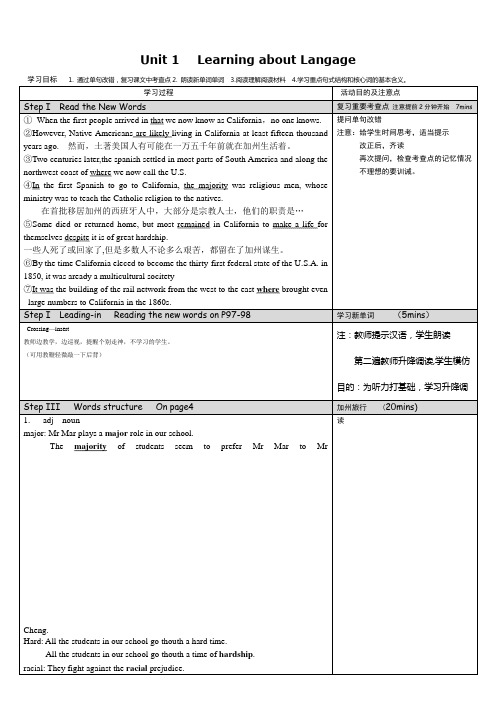
Unit 1 Learning about Langage学习目标 1. 通过单句改错,复习课文中考查点2. 朗读新单词单词 3.阅读理解阅读材料 4.学习重点句式结构和核心词的基本含义。
The Chinese belong to the yellow race.distinct:There will be no distinct major racial groups.Distinction: they have the distinction of growing fast.Korea---KoreanItaly--Italian②slave--slavery jewel---jewelry2. 3,7,draw a distinction between …and…8,9,10 elect to do be elected as…3.第五页:It didn’t occurred to me that…Step IV Listening 加州旅行 (20mins)1.Listening to the passage.①先读题目,翻译②听一遍(学生程度差,仅放前一部分)③再听一遍,学生说提示部分,重放数遍:提示:east west westernStep IV Writing (15min)_____________________________________________________________________ _____________________________________________________________;Thank you for you consideration. Yours faithfully.Signature(签名) 第一部分:开门见山第二部分切中要害,怨之有理第三部:语气委婉,重在解决问题提示学生,可以放开思路,想出其他的饭菜,或住宿问题Step V Exchange and correction 展示与修改Ask the students to read their answer slowly。
- 1、下载文档前请自行甄别文档内容的完整性,平台不提供额外的编辑、内容补充、找答案等附加服务。
- 2、"仅部分预览"的文档,不可在线预览部分如存在完整性等问题,可反馈申请退款(可完整预览的文档不适用该条件!)。
- 3、如文档侵犯您的权益,请联系客服反馈,我们会尽快为您处理(人工客服工作时间:9:00-18:30)。
高二英语选修八unit 1 第一课时Warming up & reading
Teaching Goal:
Enable the Ss to learn sth about the USA
Enable the Ss to talk about some places with frequent english
Teaching important and difficult points
Practice some important words and expressions
Part 1 Warming up
Look at the warming-up part on page 1 and fill in the map(refer to the ppt.) What do you know about the USAlet’s have a small test.
1. Which flag is American flag
2. Which city is the capital of the USA
A.New York
B.Washington
C.Los Angeles
3. Which stands for the USA National Emblems(国徽)
4. How many states are there in the USA
doesn’t belong to the USA
Part 2 Reading.
Fast reading
state in the USA has the largest Population
2. Why is California called the most multicultural state in the US
many kinds of people are mentioned in this text
Detail reading
Native Americans
•:
• did they come from:
• happened to the native Americans in the sixteenth century
Native Americans
The Spainsh
16th century 18th century in 1821 in 1846
Influence:today over 40% of Californians speak Spainish as a first or second language
Russians & Gold Miners
Do some T or F questions:
the early 1800s, Russian fur trappers began settling in California.
1848, before the Amerian-Mexican war, gold was discovered in California. lot of adventures achieved their dream of becoming rich.
4.California become the thirty-first state of the United states of Amerian
in 1850.
Later arrivals
Recent arrivals
Look at the pictures below. Each illustrates something about California. Discuss in groups what each picture means to you.
native American Indian was standing beside a camp .It seemed that he or she felt very happy. Maybe he or she had a good harvest.
was a gold miner. He was panning gold. He looked not only thin and weak, but also thirsty and tired. It was difficult for them to achieve the dream of becoming rich.
building in Chinatown
Many Chinese have settled in California and many of them live in Chinatown in San Francisco.。
